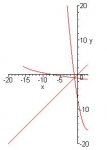You are using an out of date browser. It may not display this or other websites correctly.
You should upgrade or use an alternative browser.
You should upgrade or use an alternative browser.
Inverse Functions
- Thread starter char
- Start date
D
Deleted member 4993
Guest
char said:I have the function (x-3)^2-16=y, but I can't figure out the inverse function. Please help me!!! Thanks in advance!
Switch "x" and "y" - then solve for "y".
D
Deleted member 4993
Guest
char said:I already know that, but I can't figure out how to solve for y.
Show me how far you got and exactly where you are stuck.
mmm4444bot
Super Moderator
- Joined
- Oct 6, 2005
- Messages
- 10,962
char said:(x-3)^2-16=x Don't switch just one variable; switch them both, at once.
(y-3)^2-16=x Yes, start with this line.
y^2-9y-16=x (y-3)^2 is not y^2 - 9y, but you don't want to square y - 3.
We have:
(y - 3)^2 - 16 = x
To solve for y, means to write y = something, not y^2 = something.
So, the next step is to take the square root of both sides.
Hint: Remember that the square root of (y - 3)^2 is not y - 3. It is |y - 3|.
Thanks so much for your help! Is this right??????
(x-3)^2-16=y switch y and x so
(y-3)^2-16=x
(y-3)^2-16+16=x+16
(y-3)^2=x+16
-sqrt(y-3+3)^2=-sqrt(x+16)+3
y=-sqrt(x+16)+3
or is it
y=sqrt(x+16)+3
Also another question is that a function or not? I'm totally confused as to what constitutes a function. All I can remeber is the vertical line test and I know that either answer is half of a parabola and passes the vertical line test.
(x-3)^2-16=y switch y and x so
(y-3)^2-16=x
(y-3)^2-16+16=x+16
(y-3)^2=x+16
-sqrt(y-3+3)^2=-sqrt(x+16)+3
y=-sqrt(x+16)+3
or is it
y=sqrt(x+16)+3
Also another question is that a function or not? I'm totally confused as to what constitutes a function. All I can remeber is the vertical line test and I know that either answer is half of a parabola and passes the vertical line test.
BigGlenntheHeavy
Senior Member
- Joined
- Mar 8, 2009
- Messages
- 1,577
\(\displaystyle f(x) \ = \ (x-3)^2-16 \ is \ not \ 1 \ to \ 1, \ hence \ has \ no \ inverse.\)
\(\displaystyle f(-1) \ = \ f(7) \ = \ 0\)
\(\displaystyle f(-1) \ = \ f(7) \ = \ 0\)
mmm4444bot
Super Moderator
- Joined
- Oct 6, 2005
- Messages
- 10,962
Hi char:
Trying to learn about function inverses, while in a total state of confusion over the definition of a function, is tantamount to trying to find your way out of the middle of the forest without trail, map or guide.
Why would you do that?
As Glenn pointed out, the given function y is not one-to-one. We need to split its domain at the vertex; then, y will be one-to-one in each half.
y[sup:2y151r22]-1[/sup:2y151r22] = 3 + sqrt(x + 16) over half of y's domain.
y[sup:2y151r22]-1[/sup:2y151r22] = 3 - sqrt(x + 16) over the other half.
Determining which half-domain belongs to each of these is easy, if you understand what inverse functions do (or the symmetry with y).
Use the graph below, or pick a test value for x, and reason it out!
I welcome specific questions.
Cheers ~ Mark
[attachment=0:2y151r22]inverse.JPG[/attachment:2y151r22]
Trying to learn about function inverses, while in a total state of confusion over the definition of a function, is tantamount to trying to find your way out of the middle of the forest without trail, map or guide.
Why would you do that?
As Glenn pointed out, the given function y is not one-to-one. We need to split its domain at the vertex; then, y will be one-to-one in each half.
y[sup:2y151r22]-1[/sup:2y151r22] = 3 + sqrt(x + 16) over half of y's domain.
y[sup:2y151r22]-1[/sup:2y151r22] = 3 - sqrt(x + 16) over the other half.
Determining which half-domain belongs to each of these is easy, if you understand what inverse functions do (or the symmetry with y).
Use the graph below, or pick a test value for x, and reason it out!
I welcome specific questions.
Cheers ~ Mark
[attachment=0:2y151r22]inverse.JPG[/attachment:2y151r22]
Attachments
mmm4444bot
Super Moderator
- Joined
- Oct 6, 2005
- Messages
- 10,962
Denis said:What's wrong with ye olde quadratic [formula]?
Nothing, if that's what toots your scooter.
After checking the work in char post #3, I wanted to offer something with less steps because char is hurt'n.
BigGlenntheHeavy
Senior Member
- Joined
- Mar 8, 2009
- Messages
- 1,577
\(\displaystyle Note, \ for \ what \ it \ is \ worth \ Dept: \ The \ sine \ and \ cosine \ haven't \ any \ inverses\)
\(\displaystyle \ ( \ they \ aren't \ 1 \ to \ 1 \ functions), \ unless \ we \ put \ a \ restriction \ on \ their \ domains, \ which \ we \ do.\)
\(\displaystyle No \ quadractic \ functions \ have \ an \ inverse \ unless \ we \ put \ a \ restriction \ on \ their \ domains,\)
\(\displaystyle usually \ at \ their \ axis \ of \ symmetry, \ as \ mmm4444bot \ pointed \ out.\)
\(\displaystyle \ ( \ they \ aren't \ 1 \ to \ 1 \ functions), \ unless \ we \ put \ a \ restriction \ on \ their \ domains, \ which \ we \ do.\)
\(\displaystyle No \ quadractic \ functions \ have \ an \ inverse \ unless \ we \ put \ a \ restriction \ on \ their \ domains,\)
\(\displaystyle usually \ at \ their \ axis \ of \ symmetry, \ as \ mmm4444bot \ pointed \ out.\)

